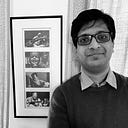Five Songs — 14
Maravakave O Manasa — Raga Sama — Patnam Subramania Iyer; Sanjay Subrahmanyam
Perhaps the most popular song in the raga Sama, along with Muthuswami Dikshitar’s Annapoorne Visalakshi, is Manasa Sanchara Re by Sadasiva Brahmendra. Of the 15th century, Brahmendra was an enigmatic figure who perhaps better than anyone defined the archetype of the composer-saint. In the sense that he seems to have truly composed a whole bunch of songs and was truly a saint — wandering about stark naked, focused only on his inner spiritual world, and generally not giving a hoot about anyone or anything — a true renunciate. The 20+ or so of his songs that we have focus on the same basic themes, advaita — our essential oneness with the eternal, maya — the illusory nature of this word and bhakti as possibly the simplest way out to connect to that eternal. His mudra, or signature phrase, was paramahamsa.
Maravakave O Manasa has some striking similarities with Manasa Sanchara Re, including the word Manasa in the opening line, the word Paramahamsa in later lines, and their tuning in the raga Sama. Perhaps Semmangudi Srinivasa Iyer, who tuned Manasa Sanchare to Sama raga sometime in the mid-20th century had Maravakave in mind when he did so. There is also a song by Thyagaraja in the raga Kedaragowla — Ramuni Maravakave O Manasa — in which he asks his mind not to forget the Lord Rama. The lyrics of Iyer’s Maravakave mirror that of Thyagaraja’s song. Perhaps this song was a tribute to Thyagaraja’s Ramuni.
Here is a wonderful rendition by Sanjay Subrahmanyam, with a fairly extensive alapana preceding the piece (which is what first caught my attention).
The song begins at 00:20:01
Devi Brova Samayamide — Raga Chintamani — Shyama Shastri; Brinda Manickavasagam
A frequent exhortation to young practitioners of Carnatic music by the more experienced is to not play the ‘raga guessing game’ with the audience — the raga should be established within the first few phrases of the alapana, preferably in the opening phrase itself. This was taken to a brilliant extreme by Brinda Manickavasagam. Somehow, as I listened to the first innocuuous note of her alapana, I knew right then that Devi Brova Samayamide would follow.
The song begins at 28:13.
Bantu Reeti — Raga Hamsanadam — Thyagaraja; Jayashree Aravind
Jayashree Aravind is a vainika of the Kerala school, having learned from KS Narayanaswamy. This school of veena playing is known for its precise, restrained style, not given to theatrics. Bantu Reeti, on the other hand is a classically emotive (read theatrical), allegorical Thyagaraja song in which asks Rama to allow him to serve him as a royal guard. This royal guard is an enthusiastic one, eager to ‘thrash’ the six ‘internal enemies’ so that they fall to the ground. This royal guard insists on being accoutred with all the accessories befitting his position — a royal badge, a divine sword and heavy armour (each signifying something in particular). The lyrics are aptly paired with the rather martial sounding raga Hamsanadam, with its focus on the upper-end of the octave.
This is a fine rendition of the song, demonstrating that in the hands of an expert, seemingly antithetical style and substance — in this case the inherent equanimity of the Kerala school of veena, and the insistent melodrama of Bantu Reeti — need not be in conflict, and can at times bring out the best in each other. The rest of the concert is also excellent, especially Paramatmudu in Vagadeeshwari and Tarunam Idamma in Gowlipantu.
The song begins at 00:23:57
Paripalinchu Mani — Raga Suddha Saveri — T Venkataramana Iyer; Semmangudi Srinivasa Iyer
Those familiar with Semmangudi Srinivasa Iyer’s music will know that Thyagaraja’s Darini Telusukonti in Suddha Saveri is one of his hallmark songs. But he usually sang it early in a concert, without much of an alapana to precede it. I’ve selected this piece as much for the alapana as the vigorous composition that follows. While just a 6-minute alapana, it is complete and substantial, giving the raga the play it deserves. The composition is of one Tiruvisainallur Venkataramana Iyer, who I assume was a 20th century Carnatic dabbler-composer. (Not to be confused with TL Venkatarama Iyer — lawyer, student of Ambi Dikshitar and guru to DK Pattammal).
The song begins at 00:52:57.
Nithya Rupa — Durbar — Thyagaraja; Madurai Mani Iyer
I am a recent convert to the music of Madurai Mani Iyer. I only really got into his music in the last year or so. I had tried listening to his music a long time ago, but was put off by a few superficial factors — the ‘eee’ and ‘ooo’ sounds in his alapanas, the penchant to seemingly trail off into mini-alapanas while singing swara-kalpana and his frequent lack on enunciation of the words. The more I listened to him though, the more all of this faded into the background. The sheer musicality and freedom with which he sang won me over. Much is made of his captivating swara-kalpana singing — how it seems simple, but is difficult to pull off (apparently he tends to sing swaras in even-number patterns like 4, 6 etc., while the conventional wisdom and training is to sing in odd-number sets of notes — 3,5 and so on). For me though, the highlight is usually his alapana and krithi rendition itself. I will share more of his music over time, and hopefully will have a lot more to say. For now though, enjoy this rarely heard krithi of Thyagaraja’s in the raga Durbar.
The piece begins at 00:17:09.
Thank you for listening!
